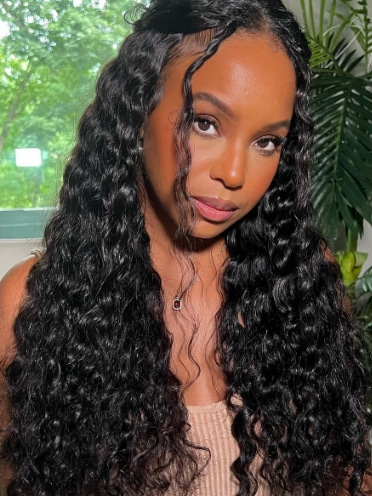
How To Prepare Your Natural Hair For A Wig
Wigs have already been a protective style for natural hair and have gotten more and more popular in recent years. However, in order to make a wig look more natural, it is important to know how to prepare your natural hair for a wig. In this blog, we will provide a detailed tutorial about how to prepare your hair for a wig.
Make Your Natural Hair Is Clean
First of all, before wearing a lace front wig, you must make sure your natural is clean. After all, if you haven’t washed your natural hair for a few days and your scalp is sweaty and filled with the build-up of products, wearing a wig can be detrimental to the overall health of your scalp in the long run. Depending on their breathability and the structure of the wig cap, wigs can contain bacteria and dirt that can disrupt the natural pH of the scalp, thus causing dryness and flaking.
To keep your hair and scalp healthy, please clean natural hair and scalp regularly. But the most important thing is to ensure your natural hair is clean before you install a wig. Therefore, if you’re planning to wear your wig for an extended period, your natural hair could become dry, so please ensure that you’ve washed and cleansed your hair thoroughly before wearing your wig. If you have a human hair wig, you had better use a hair mask to deep-condition your natural hair to keep your natural hair moisturized. Of course, it would be better to use a wide-toothed comb to brush your hair to remove any tangles or knots.
Ensure Hair Is Dry Before Installing A Wig
It is important to make sure your natural hair is totally dry before applying the wig, too. That is because a mass of wet or even damp natural hair gathered under a wig cap is not only extremely uncomfortable but can also promote the growth of nasty bacteria. The moisture mixed with body heat and extra warmth from the layer of wig can cause the growth of mildew and germs. So we should avoid it at all costs!
Prepare Hair For A Wig
Unless you are bald, you need to decide what to do with the natural hair under a wig. Some people might pull their hair back in a ponytail. In fact, it will lead to hair breakage and doesn’t seem to work. There is more than one way you can flatten your natural hair for a wig.
Braids

There is doubt that braiding your natural hair is one of the best and easiest ways to hide your hair under a wig. Although braids are not as flat as other styles, they can perfectly protect your natural hair and make it easier for women to maintain natural hair and scalp. For example, when you want to cleanse and moisturize your natural hair or scalp, it allows you easier access to the scalp.
How To Braid Short Natural Hair
Step One: Divide your natural hair into two sections from the middle part and then braid both sections.
Step Two: Take one braid and take it under the opposite braid and up round the front of your head, then secure with some pins.
Step Three: Take your second braid and cross it under the opposite braid and bring it to the front of the head, secure with some pins tightly again.
How To Braid Long Natural Hair
Step One: Tie hair into a ponytail at the crown of your head and divide the hair equally into 4 sections and braid each section.
Step Two: Take one braid and wrap it around your head about an inch away from your hairline and use some pins pin to secure every few inches.
Step Three: Repeat the above operation, don’t forget to wrap each braid behind the rows of the previous braid.
Step Four: Use the final plait to wrap it into a spiral and end it at the base of the original ponytail.
Twist

The twist is the easiest way to wear your natural hair under a wig.
How To Twist Your Natural Hair
Step One: Use a wide-toothed comb to brush your natural hair and then slick back the hairline with gel.
Step Two: Part your hair down the middle, grab one of the two strands and pull it back like you were trying to put it in a tight ponytail.
Step Three: Twist it until it starts rolling up like a snail.
Step Four: Fix it at the back of your head with some pins.
Step Five: Repeat the same steps on the other side.
Cornrows

As a traditional braid, cornrows are very close to the scalp. In addition, it is often considered a protective hairstyle for African curly hair.
Step One: Use the tail of a rattail comb to part the individual section before you begin braiding. You may begin by braiding the small section at the hairline.
Step Two: When you are braiding the section of the hair and picking up one of the three pieces of hair to braid, turn it into a cornrow by pulling hair from the parted off section and adding it to the one you are braiding. This process attaches the braid to the scalp.
Step Three: Continue to braid your natural hair on the scalp and add more hair into the cornrow and braid it just like the regular braids until you reach the end of that section. In the process, please make sure that you have sections that are of the same size to make the cornrows look even.
Step Four: Secure the end of the braided hair to prevent the cornrows from disengaging. You may use snap-free rubber bands or barrettes to secure them for straight hair. You may also make the end of the cornrows into a navel hairstyle. Meanwhile, for natural hair, you may just curl them around your finger.
Buns

Do you know the best place to hide your natural hair under a wig is in the neck socket? Because most headband wigs have a little extra stretch in the area to accommodate it. If you have enough long hair, you can try to style it in a bun. What easy and nice it is!



























Submit Your comment